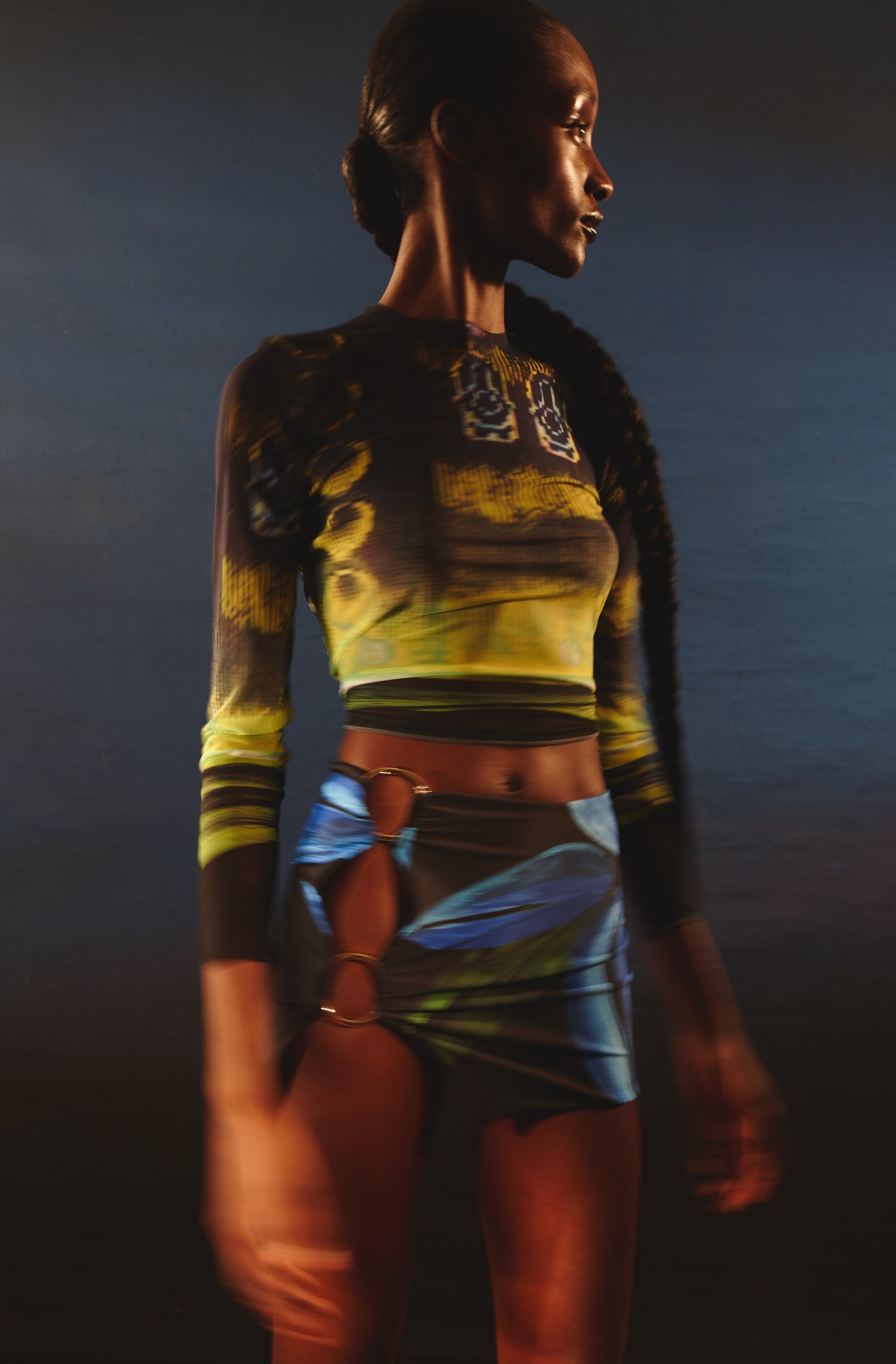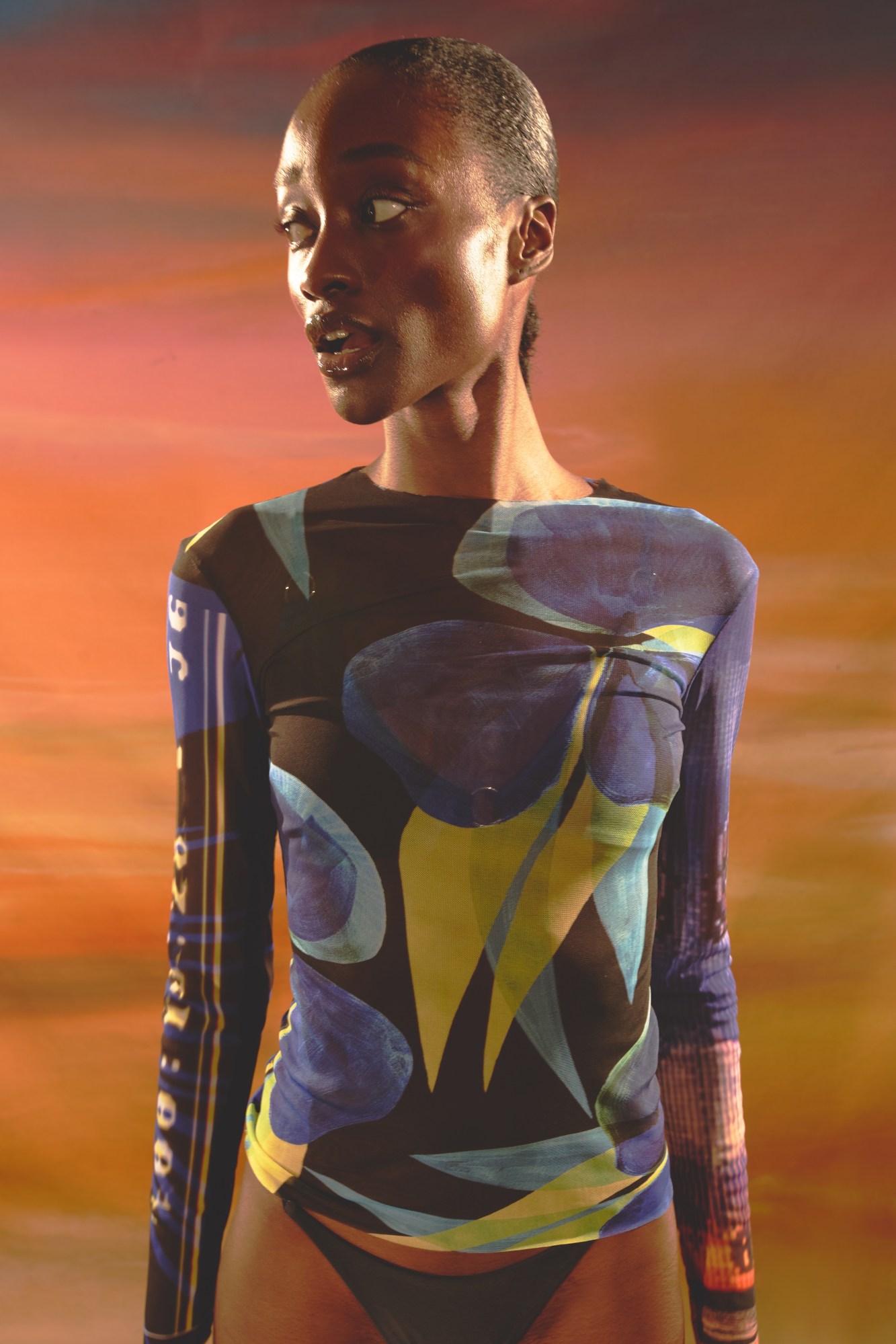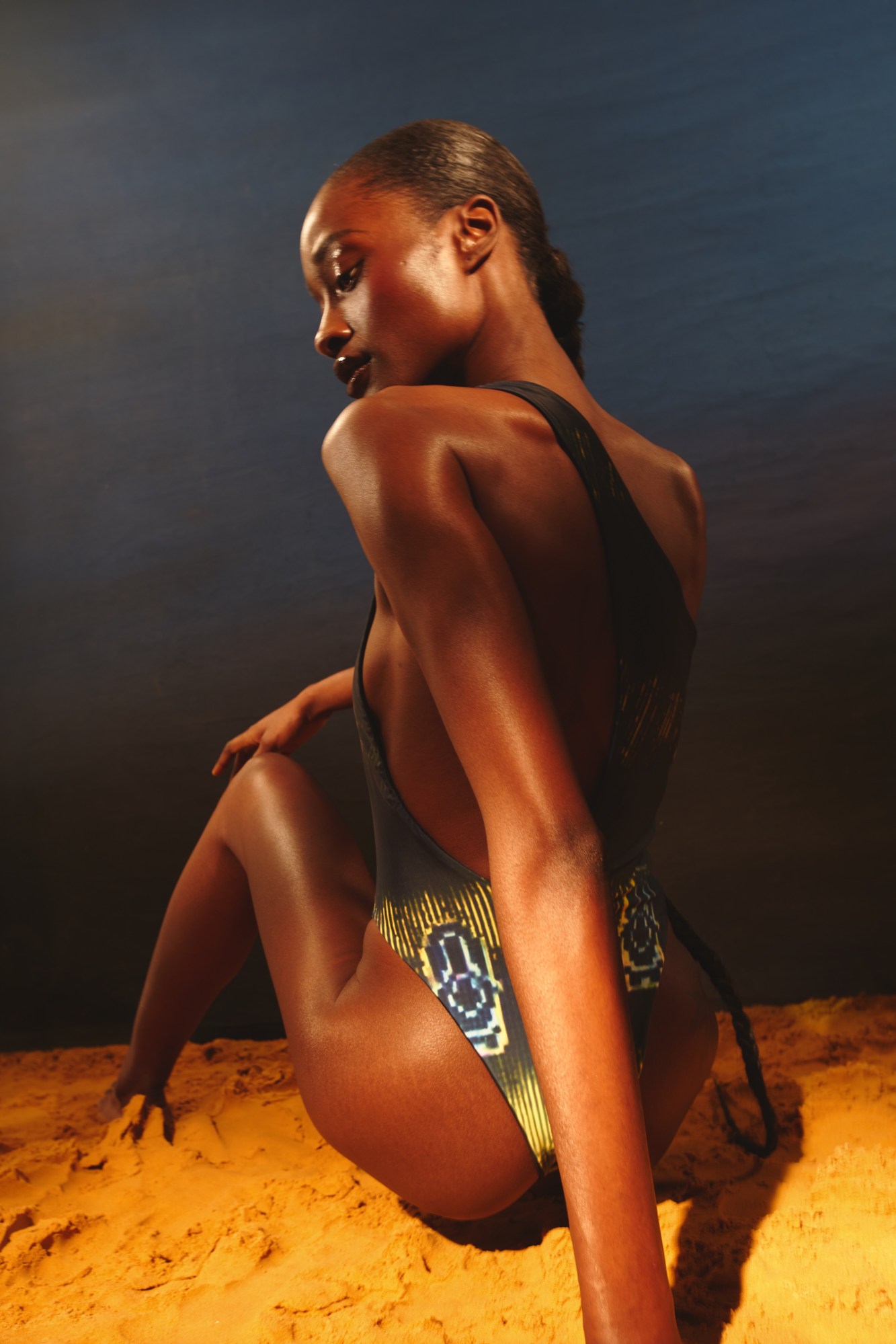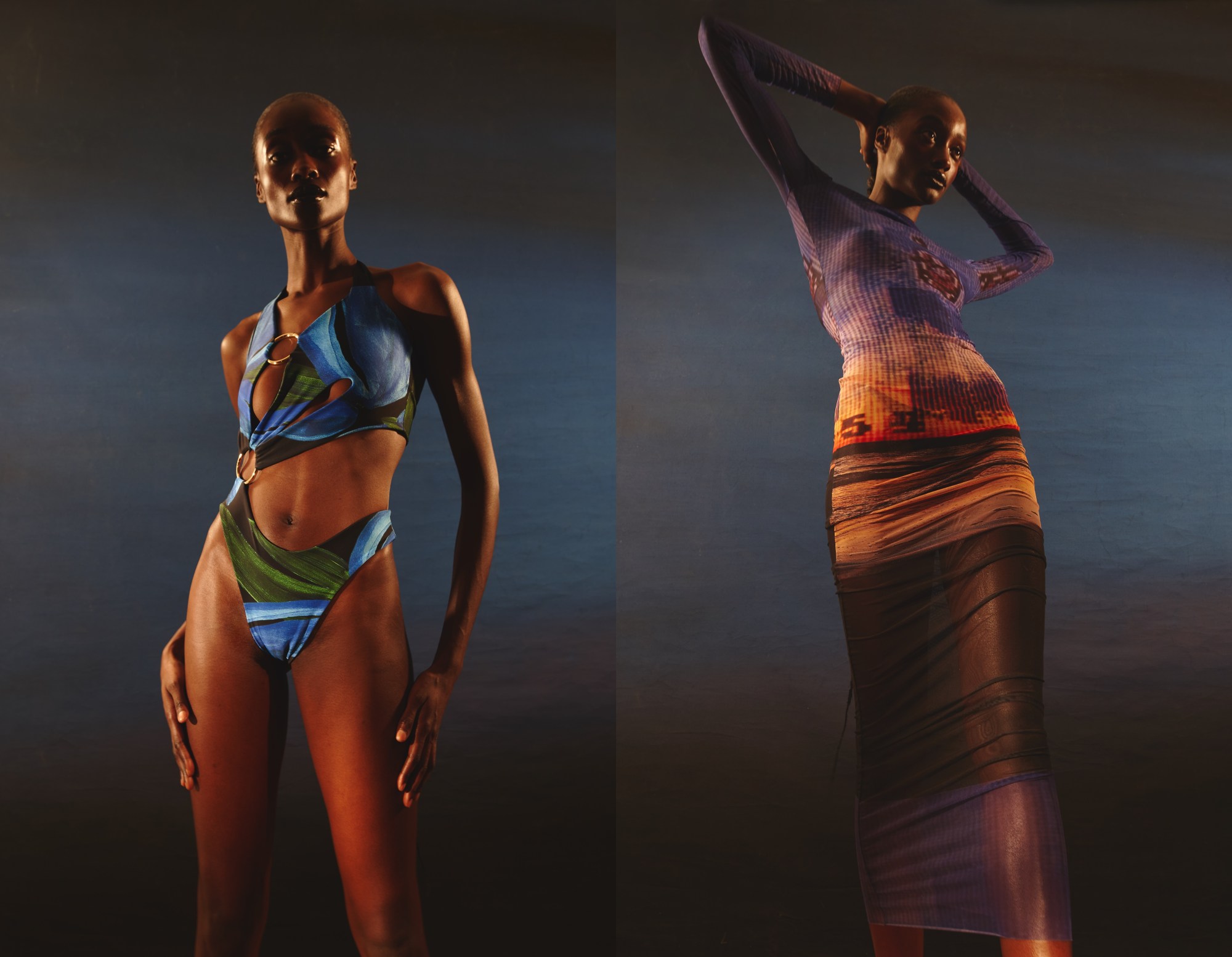Looking at Louisa Ballou’s work for the first time triggers a sort of Baader-Meinhof effect — see it once, and it seems to crop up everywhere. That might be down to the young designer’s widely-followed devotees, who have ceaselessly populated our feeds with selfies in her namesake brand’s bright, cut-out swimwear since its official launch in 2019. Kendall and Kylie Jenner, Bella Hadid, Imaan Hammam, Megan Thee Stallion… the list goes on.
It isn’t, however, the bodies wearing the pieces that keep them front of mind. Put simply, there just isn’t anything quite like Louisa’s work out there at the moment. The liquid drape of dresses and one-piece swimsuits is sensual, composed of asymmetrical stretches of lycra bound by strategically placed metal o-rings. And the tropical prints that decorate the pieces — which also include surf tops and bodycon mesh dresses — make them instantly recognisable.

These items have their roots in ‘Sex Wax’, Louisa’s 2017 Central Saint Martins graduate collection — and the name of a popular brand of surfboard wax. A Charleston, South Carolina native, the designer drew inspiration from the beach culture she grew up with, as well as from the tropical hues that colour her hometown. After a couple of years working in the industry, it’s where she returned to start her brand. The beach-ready silhouettes and the designer’s surfing pedigree aside, life in her Southern hometown makes itself felt in Louisa’s hallmark prints — painterly florals and reed-like ribbons in sunny yellows and seaweed greens, for example.
For her AW20 collection, she’s taken a new aesthetic direction, turning to the graphic landscapes of vintage Nintendo games and the hyperreality of Miami at twilight. “I didn’t want to just do florals, I wanted to show that there are other facets and viewpoints to the brand,” says Louisa. “The combination of organic and more graphic elements created an interesting contrast, a kind of edgier feel.” This is accentuated in the collection’s campaign, shot by Aidan Zamiri against hand-painted backgrounds that seem to convey a faintly vaporwave vision of a beach at dusk.
To hear more about her how she develops her unique visuals, as well as how she deals with celebrity endorsements and the consequent hype, we got on a call with Louisa, on lockdown in Charleston.

You don’t typically see much swimwear coming out of the London schools. What drew you towards it during your time at CSM?
I’ve always been around the water, as I grew up on the beach, competing in local surf competitions. But I never actually considered doing swimwear until my final year on the BA. What I was doing wasn’t quite working, but then finally over the break between our pre-collection and main collection, something clicked and I started working on a few pieces that were more swimwear-based.
Still, your approach seems to take a lot from more typical dressmaking techniques, particularly where the draping’s concerned.
Absolutely, and I’ve always loved pattern cutting, too. I really wanted to take these skills I’d learned and apply them to swimwear. At the time, though, I wasn’t really thinking of continuing it after graduation, but there was a lot of interest in it and things just grew from there. The other element that’s always been important for me is print. The way a print looks on the body has so much to do with how a garment actually fits you. If it just sits on top of you and does nothing for you then I won’t include it.
There’s often an interesting harmony between the fluidity of the visuals and the pieces’ forms. What’s the typical starting point for your print development?
I always start by painting, and it kind of goes back to where I’m from. Charleston’s a very tropical environment. Lots of vibrant colours. It’s something I didn’t really appreciate until I moved to London, which is such a contrast because it’s so grey by comparison. I’ll use different references from my research — just whatever I find striking, really. But I always settle on the colour palette first, and then from there I work on the shape and how it sits on the body.

People are often eager to categorise fashion — what are your thoughts on being termed a ‘swimwear brand’?
Well, to me, the brand exists very much between swimwear and ready-to-wear. We have both, and often the pieces can be worn as both. The labelling doesn’t matter too much to me, because my customer gets it. They see that they can wear it on a night out as easily as they could to the beach, depending on how they style it.
Swimwear will always be at the heart of the brand, but I want to keep developing and seeing what people respond to and how it’s working as a whole. I definitely want to keep moving the ready-to-wear side of things, too, by introducing new fabrics — right now, I pretty much just work with lycra and mesh.
You worked at Loewe for a while after your graduation. How did your experience in such a coded ready-to-wear environment inform your approach to Louisa Ballou?
It really was an amazing internship, I learned so much and the people were great. But for me, it was amazing to see how the entire company worked — everything was in one building. You could see how the design team worked with the production team, who worked with sales and the showroom — you really saw how all of that came together to form a whole ecosystem. In terms of design, it really trained my eye to look at details in a more refined way and to really be tough on myself about whether things were quite right or not.

Your work has attracted some pretty significant celebrity endorsements. That can be a massive boost for a young brand, but at the same time, it can pose challenges. You might not have the production infrastructure in place to meet the subsequent uptick in demand, for example.
Totally, I completely agree. For us, it’s all about slow, healthy growth. I don’t want to blow up and be everywhere overnight, I’m really looking for longevity with what I’m doing. As far as the celebrity endorsements go, though, they were all a surprise to me. I didn’t actually know that Kylie and Kendall Jenner had bought those pieces, so it was so surreal when I saw them on Instagram. I think it’s great when it happens, and I’m really excited and grateful that I have these cool people wearing my designs, but I don’t expect it and I don’t rely on it.
What means the most to me is the return customer, whether they’re a celebrity or not — someone who loves wearing the brand and buys it repeatedly. It shows that they actually like it, and didn’t just wear it to take a picture and then never want to buy anything else again. I think that when a product is really good, it speaks for itself, and people are gonna want to buy something else, or wear it again and in different ways.
A large part of the visual presence of the brand focuses on the people who wear it. How would you describe the Louisa Ballou woman?
I think she definitely has a sense of style and a sense of her own sexuality. She embraces her body when she wears it. She’s a smart woman, too — our customers know how to wear the clothes, which is important, given how they fit the body and all the bright colours. When I’m designing, I’m always conscious the clothes don’t take over. With the women that wear the brand, they wear the clothes — the clothes don’t wear them.


Credits
Photography Aidan Zamiri
